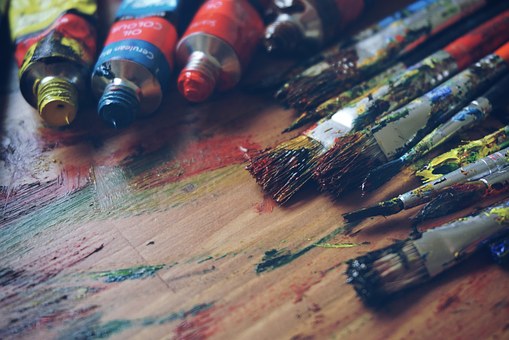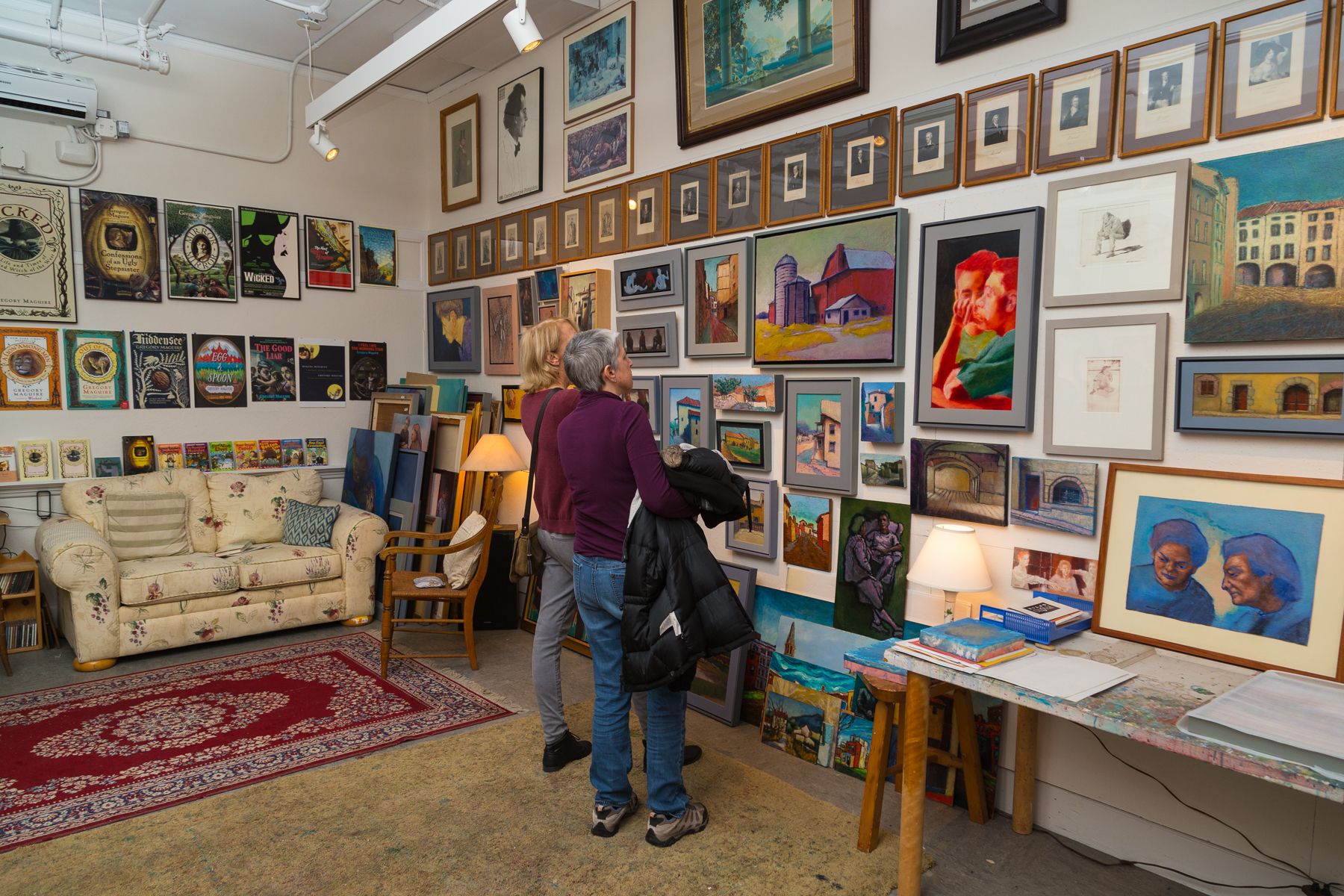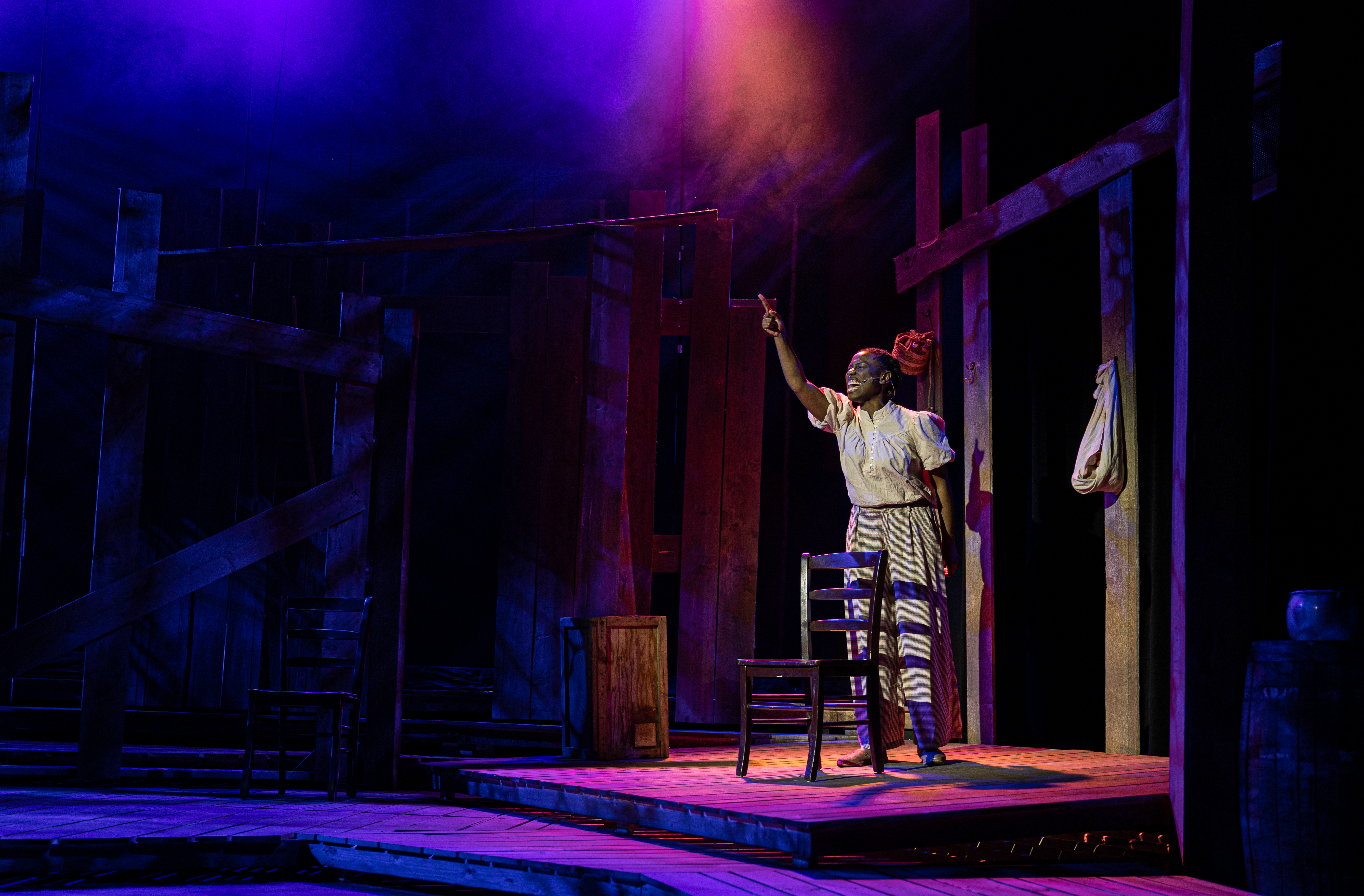2022 Art Ramble
2022 Art Ramble
In the Balance
September 1 - November 19
Hapgood Wright Town Forest
Hours: 30 minutes before sunrise to 30 minutes after sunset
Curator Talk
Sunday, October 16, 11-11:45AM
Rain Date: Sunday, November 5, 11-11:45AM
Free and open to the public
Artist Reception & Walkabout
Saturday, September 17, 4:30-5:30PM
Free and open to the public
CLICK HERE TO VIEW THE ART RAMBLE 2022 MAP!
CLICK HERE TO VIEW A VIDEO FROM ART RAMBLE 2022!
“In the Balance” is an outdoor exhibition of dynamic artworks that express a striving to regain balance with their surroundings, and to bridge the growing chasm between the loss of habitat and life’s persistence. The acceleration of climate change has reached the point of overpowering and upsetting the carefully balanced ecosystems of our surviving forests. The ground beneath our feet is literally slipping away. This artwork responds accordingly. Sound pieces, installation, sculpture, and poetry suggest recombinations, contortions, and orientations toward a new hybrid, symbiotic and sympathetic relationship with nature. Taking inspiration from the forest’s ability to regenerate itself over time, and the ability of the natural world to adapt under challenging conditions, how can we synchronize our existence with these restorative processes as we follow the path that lies before us? How do we live life in the balance?
Art Ramble is an annual, temporary exhibition in the Hapgood Wright Town Forest in Concord, MA, a collaboration of The Umbrella Art Center and Concord’s Division of Natural Resources (CDNR). Following Leave No Trace principles, regional artists create site-specific artworks promoting appreciation of nature, installed along Fairyland Pond and parts of the historic Emerson-Thoreau Amble connecting Concord Center to Walden Pond.
Participating Artists
- Paul Angiolillo
- Dave Ardito
- BARD
- Laurie Bogdan
- Bill Cohn
- Robert Greene
- Carolyn Enz Hack
- Belen Millan
- Wanda Strukus
- J.D. Trejo-Maya
- Rebecca McGee Tuck
Paul Angiolillo
Family #1 and Family #2 (2016-2022)
Hardwoods and other natural material
Artist Statement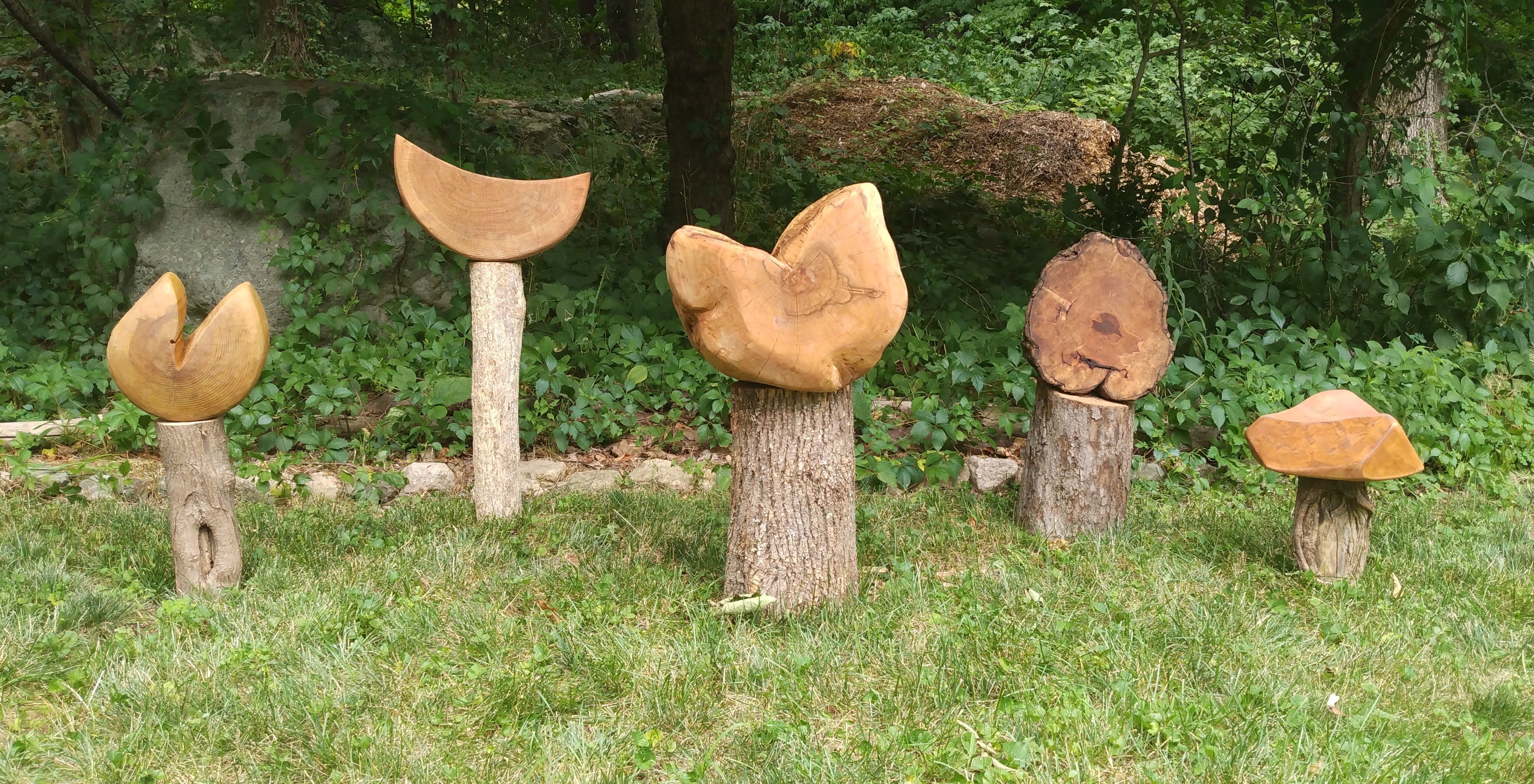
These two installations, “Family #1” and “Family #2,” each composed of several pieces, are meant to evoke and to celebrate the beauty and diversity of our natural environment. Arranged somewhat like totems, the shapes in Family #1 and compositions in Family #2 are distinct yet also play off each other--as healthy groups should. I hope that these groupings also express a sense of balance, both aesthetically and, of course, physically. Some of their shapes can also be viewed as both “taking off” and grounded--which is another kind of balance, physically and symbolically.
Bio
I studied wood carving with Boston-based sculptor Joseph Wheelwright and stone carving with Peter Smith (Princeton NJ) in the 2000s, while also working as a journalist and an editor. I graduated from Yale U. with a B.A. in literature and Humanities. I’m attracted to both figurative and semi-abstract artistic styles, using wood, stone, and other materials to fashion indoor pieces, outdoor sculptures, and also some furniture art. My “influences” are wide-ranging, coming from both Western and Eastern traditions, and both ancient and contemporary. Today, my sculptures can be viewed (and purchased) in the Fuller Craft Museum gift shop (Brockton MA), various Boston-area galleries, regional fine art and craft shows, and outdoor sculpture exhibits.
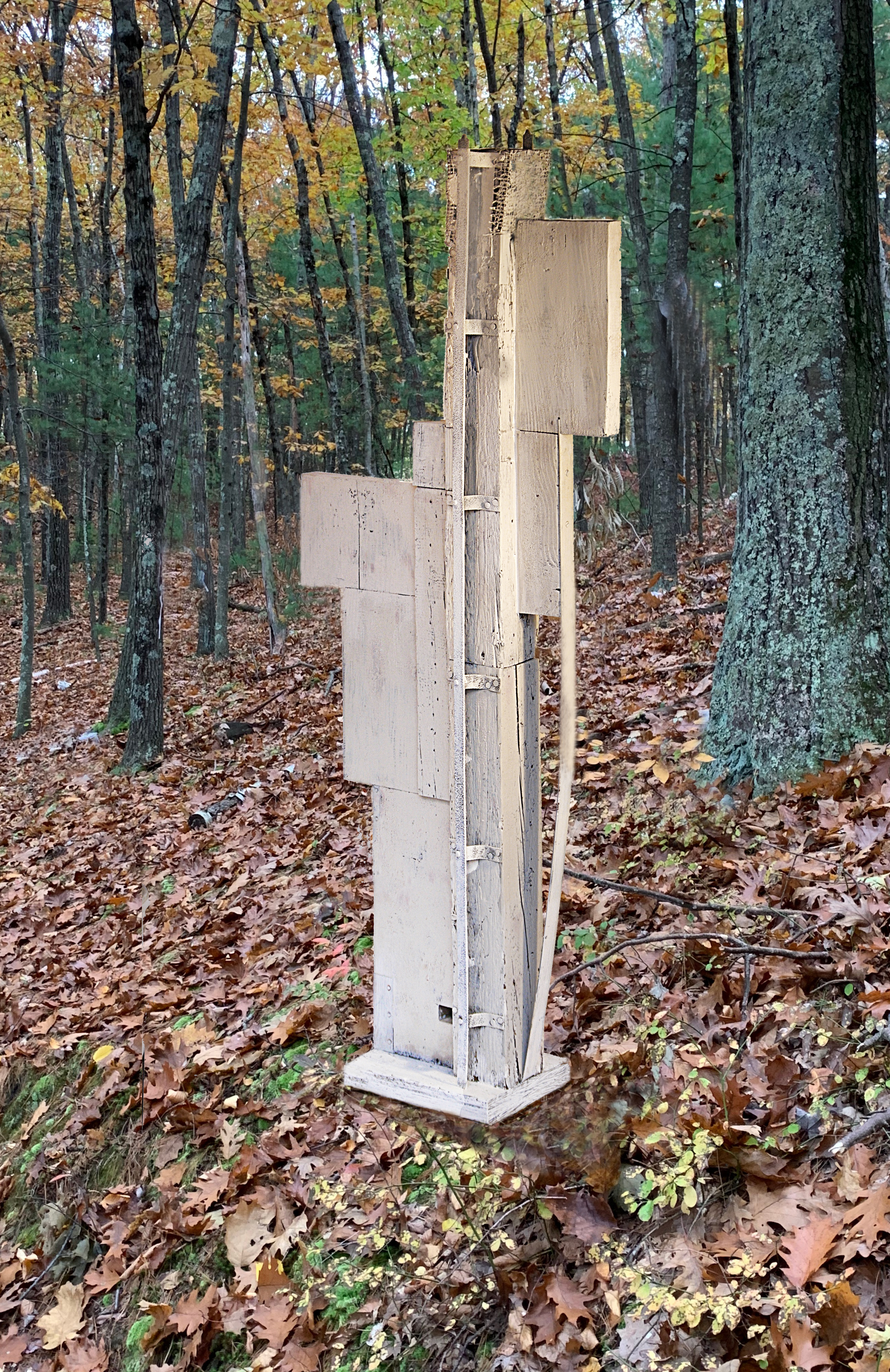
David Ardito
White Timber II (2018)Found wood, found metal pieces
Artist Statement
This work follows a series of sculptures that suggest horse forms but it is also non-objective when viewed out of the context of that earlier work. Each piece of unalteredfound wood is pieced together with others to form a balanced and unified whole. The work is three-dimensional but exists mostly within a single two-dimensional plane. This creates an intentional tension between those two dimensions as the piece alternately denies one and then the other. While the found wooden timbers have been previously milled and processed, the nearby trees that I view as part of the installation remind the viewer of the dependence this piece (and humans in general) has on these beautiful vertical and living resources without which this piece could not exist. As with the other work in this exhibit called “Metal String Bump”, I envision this piece coexisting for a while within a peaceful, natural, woodland setting for viewers to confront quietly, and to connect to in their own personal way.
Metal String Bump (2022)
Found rusted metal objects, cement, steel
Artist Statement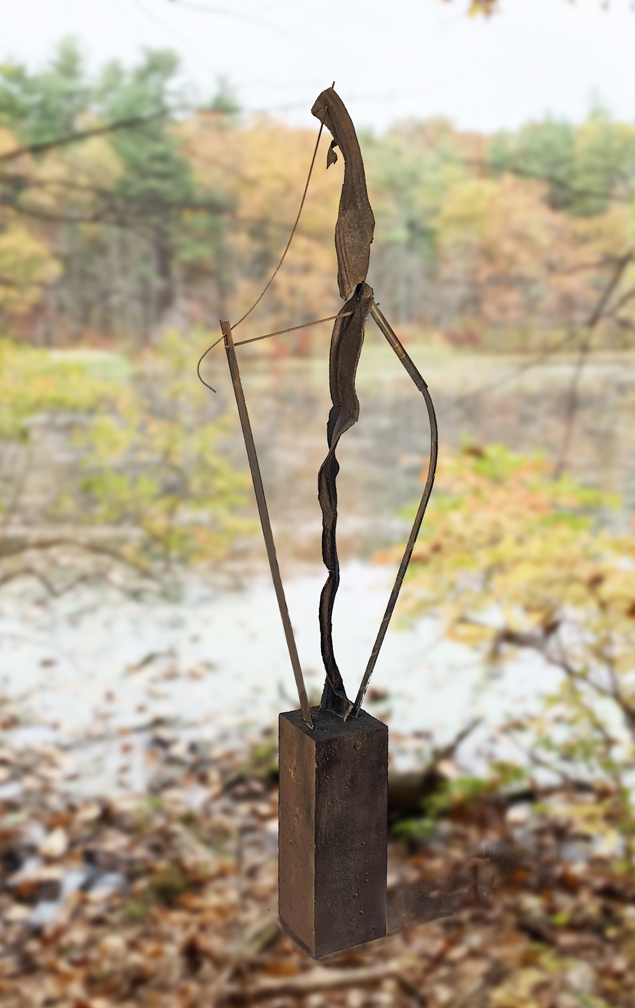 One of the things that this work represents is the randomness and serendipity of the art making process. The found materials, including the rusted metals within the piece, have as much control over the way the piece develops as the artist does, if not more. The nature and limitations of the materials dictate how they are attached, manipulated and combined to form as cohesive and balanced an object as possible. Giving control to the materials frees the artist to simply problem solve and to let the piece find its own form and reason for being. The piece also pays tribute to the decaying process that is intrinsic to and inevitable for all man-made and organic things. This work can live in an outdoor setting where the decay process is allowed to continue or indoors where it contrasts starkly to precious objects that are protected to maintain their comfort and value. The viewer might also feel a reference to music, particularly string instruments and musicians, and with that a suggestion of movement and rhythm within the piece. I envision this piece coexisting for a while within a peaceful, natural, woodland setting for viewers to confront quietly, and to connect to in their own personal way.
One of the things that this work represents is the randomness and serendipity of the art making process. The found materials, including the rusted metals within the piece, have as much control over the way the piece develops as the artist does, if not more. The nature and limitations of the materials dictate how they are attached, manipulated and combined to form as cohesive and balanced an object as possible. Giving control to the materials frees the artist to simply problem solve and to let the piece find its own form and reason for being. The piece also pays tribute to the decaying process that is intrinsic to and inevitable for all man-made and organic things. This work can live in an outdoor setting where the decay process is allowed to continue or indoors where it contrasts starkly to precious objects that are protected to maintain their comfort and value. The viewer might also feel a reference to music, particularly string instruments and musicians, and with that a suggestion of movement and rhythm within the piece. I envision this piece coexisting for a while within a peaceful, natural, woodland setting for viewers to confront quietly, and to connect to in their own personal way.
Bio
David Ardito is an arts administrator, art teacher and visual artist living and working in Arlington, Massachusetts. He attended the Cooper Union for the Advancement of Science and Art in New York City and the Syracuse University Graduate School of Visual Art receiving his BFA (1969) and MFA (1971) degrees respectively. He served for thirteen years as K-12 Director of Visual Art for the Arlington Public Schools until this past year where he supervised 16 art teachers in the ten public school buildings in Arlington. He also served as K-12 Director of Visual Art for Winchester Public Schools from 1989-2007. He taught visual art at the middle and high school levels for many years. He joined the Art Education staff at Mass College of Art and Design in 2007 and co-supervised the Saturday Studios youth program there until 2015. Over the past several years, his personal artwork transitioned from two-dimensional art forms to three-dimensional sculptural forms in wood, marble, clay and an assortment of other media. As a long time Arlington resident, he is also very committed to the promotion of visual and performing arts in Arlington and beyond and has served on numerous Arlington arts committees including the Arlington Art Lottery Council, the Arlington Commission on Arts and Culture, and the Arlington Public Art Committee.
BARD
Ancient Treasures (2022)
Crystalline resin and gold wire
Artist Statement
While the need to plant trees is strongly rooted in the current public discourse and mind, I want to delve deeper and bring awareness to the intricacies of our ecosystem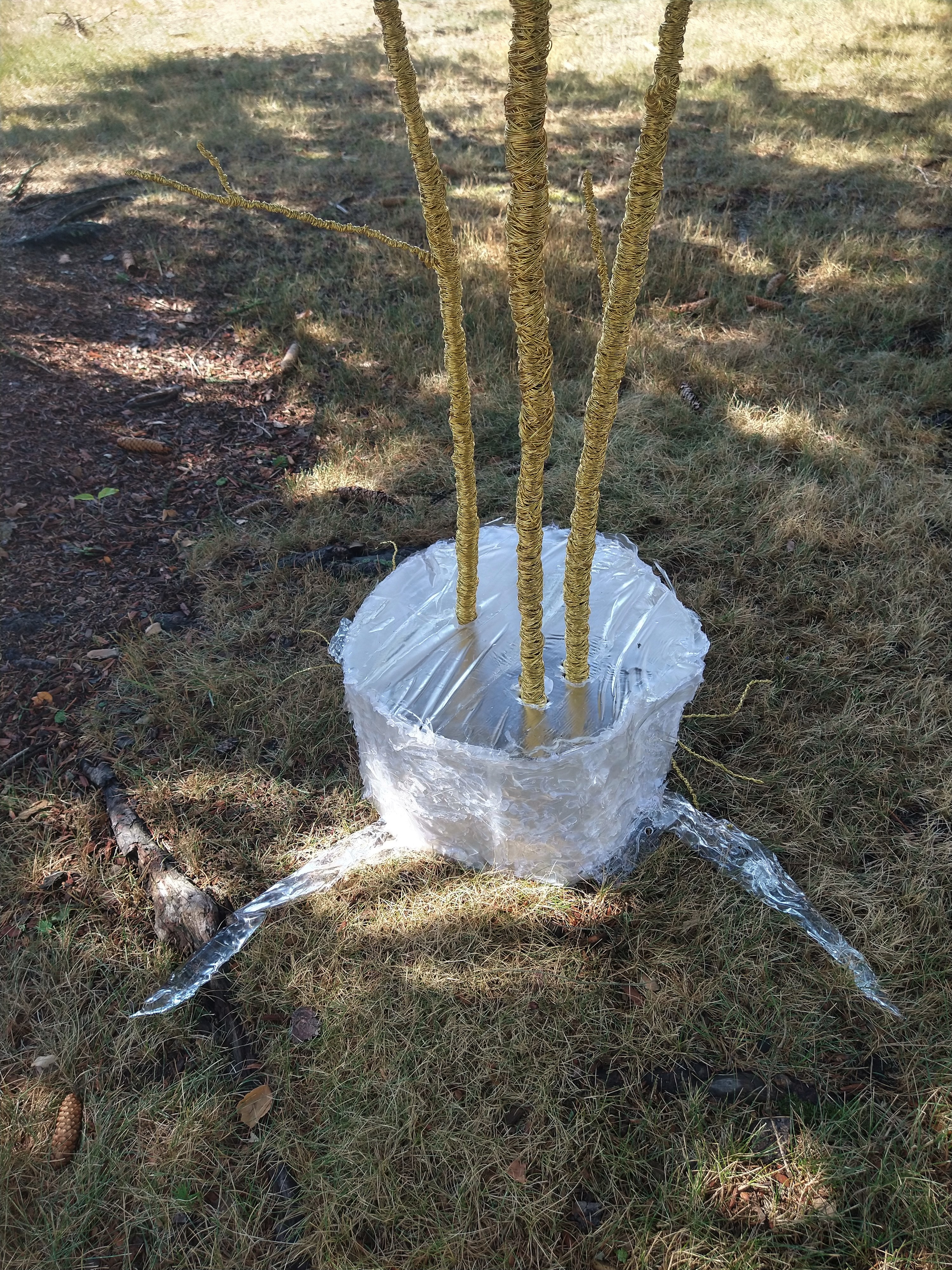 management and renewal. While any amount of trees are beneficial, the idea of planting trees to combat the ones we are destroying is not sustainable. Preserving forests, especially ancient forests, is critical to maintaining balance within our ecosystems and climate. Trees that make up ancient forests, or old growth forests, generally defined as biodiverse forests 140-250 years old, have innumerable benefits including increased carbon capture, deeper root systems to combat erosion, greater resilience to heat and drought, provision of communication in the form of fungi and healthy bacteria throughout the forest, and can have deep ties and significance to indigenous cultures. “Ancient Treasures” questions the narrative told about valuing new planting over preservation, the invisibility of ancient trees, the current imbalance in policy and protection, and the hidden worlds we can still discover in the inner workings of a forest.
management and renewal. While any amount of trees are beneficial, the idea of planting trees to combat the ones we are destroying is not sustainable. Preserving forests, especially ancient forests, is critical to maintaining balance within our ecosystems and climate. Trees that make up ancient forests, or old growth forests, generally defined as biodiverse forests 140-250 years old, have innumerable benefits including increased carbon capture, deeper root systems to combat erosion, greater resilience to heat and drought, provision of communication in the form of fungi and healthy bacteria throughout the forest, and can have deep ties and significance to indigenous cultures. “Ancient Treasures” questions the narrative told about valuing new planting over preservation, the invisibility of ancient trees, the current imbalance in policy and protection, and the hidden worlds we can still discover in the inner workings of a forest.
Bio
Originally from Nevada, BARD currently works and lives in Massachusetts. She brings her diverse backgrounds into her art subject matter and processes, having received a BA in Theater and English from Brandeis University and an MA in Sustainable International Development from the Heller School for Social Policy and Management. Their attraction to mixed media stems from both their work as an environmental educator and a personal creative curiosity. By using found items and reusing her own objects and clothes, she both reduces waste and explores the tangibility of art. In many of their pieces they utilize 3-D elements to redefine who can interact with visual art, adding Braille and durable interactive elements to allow blind and low-vision audience members to enjoy their work. Her art has been featured in solo and group exhibits in seven states across the country, as well as internationally.
Laurie Bogdan
Symbiotic (2022)
Plastic bags and mylar
Artist Statement
Tree Fungi help remove carbon from the atmosphere which could help us reduce the effects of climate change. By cycling essential nutrients, fungi also help prevent soil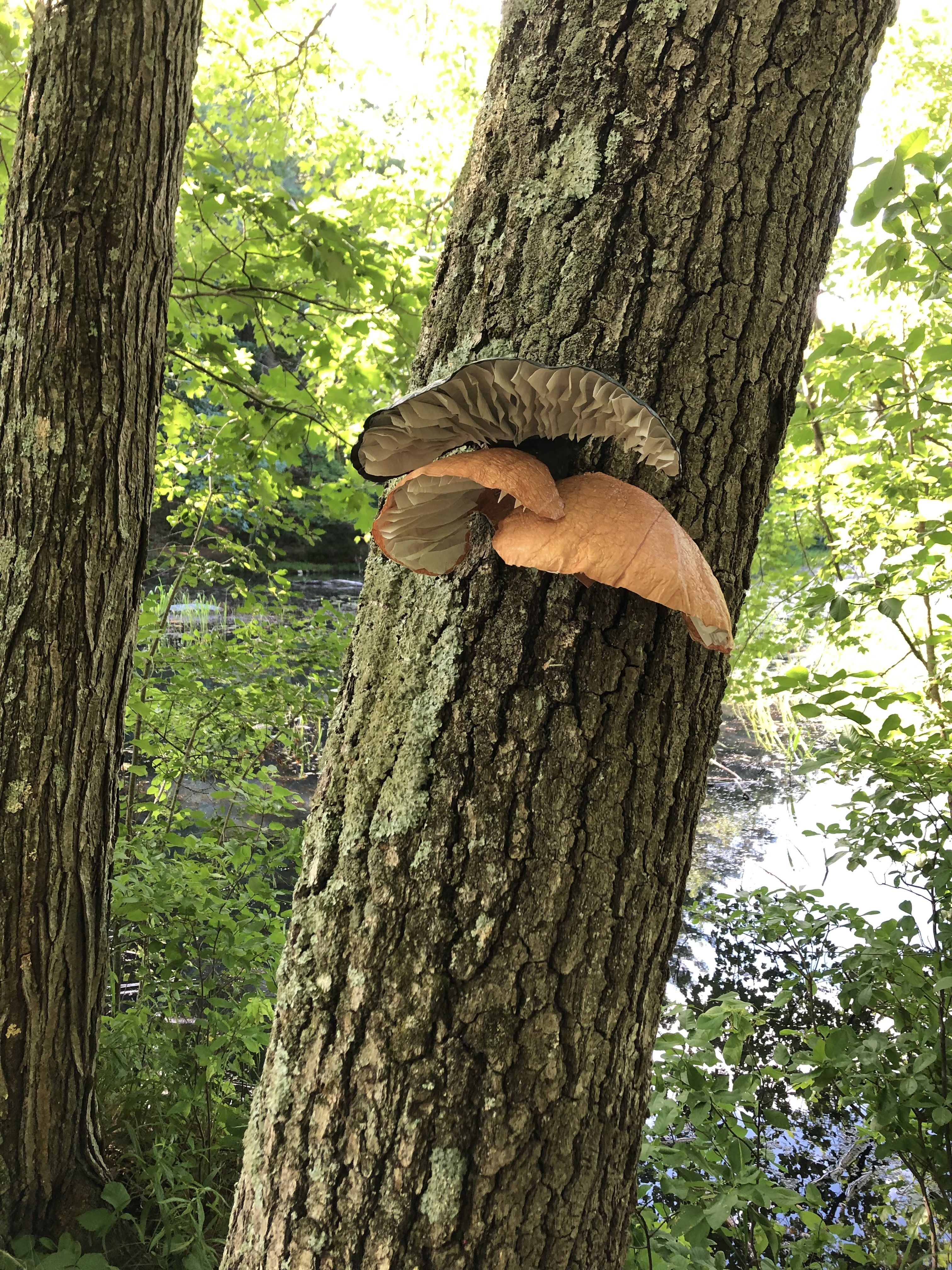 degradation, so that the land can continue to produce food and sustain life. This installation is a representation of chanterelle and chicken of the woods, which are a polypore fungi. Polypores are a group of fungi that form large fruiting bodies with pores or tubes on the underside. They are found on wood, and their job is to break down the lignins in the wood. Fungi are great recyclers. Many of the harder polypores can live for a whole year or longer, and we can always find them in the forest in different stages of freshness and ages. While polypores tend to dull and toughen with age, they can be brilliantly colored and flexible when fresh.
degradation, so that the land can continue to produce food and sustain life. This installation is a representation of chanterelle and chicken of the woods, which are a polypore fungi. Polypores are a group of fungi that form large fruiting bodies with pores or tubes on the underside. They are found on wood, and their job is to break down the lignins in the wood. Fungi are great recyclers. Many of the harder polypores can live for a whole year or longer, and we can always find them in the forest in different stages of freshness and ages. While polypores tend to dull and toughen with age, they can be brilliantly colored and flexible when fresh.
Bio
I am a collage artist from Arlington MA. In a world where many ordinary objects and books are tossed away or not appreciated, it’s nice to find a way to reimagine and bring new life to them. My focus this past year has been to use a variety of these materials to create public art. I enjoy collaborating with fellow artists with complimentary skills. This allows me to stretch my imagination. I volunteer with ArtLinks Arlington, a local networking group, and Arts Arlington.
Bill Cohn
Stasism (2014)
Ceramic, rock (base), metal
Artist Statement
Balance, and the improbability thereof, is thematically central to “Stasism”. “Stasism” is a cairn, a rock-stack (in this case using ceramic “rocks”) which, like those one might encounter on a mountaintop or remote trail, can be a godsend; they reorient and reassure by communicating that "others have passed this way". The indigenous peoples and early settlers of Concord, like others throughout New England and beyond, have since prehistory built cairns as trail markers, burial monuments, and for ceremonial purposes. Cairns invite reflection and pause, and prompt the instinct to touch. The impermanence of a balanced stack of rocks is a metaphor for our own lives. We stack our life experiences with the hope that we’re growing to be steady, strong and upright. But with the climate itself changing we’re forced to question whether we, and our surroundings, can maintain our balance. Will we hold on or will we topple, erasing the evidence of lives well-built and paths our descendants should follow?
Bio
Bill Cohn is drawn to the earth where he finds peace when digging soil and breathing forest air. Similarly, touching and manipulating clay, rock, and wood grounds him and unleashes his creative spirit. His sculptural work emphasizes texture and movement. Many of his pieces play with the improbability of balance, which can leave viewers intrigued, but a bit unsettled. Bill Cohn has been a ceramic artist for more than 30 years. His work has been featured in solo, two-person, and juried group shows, with gallery pieces as well as outside sculpture. Cohn works from his studio at Artspace Maynard, where he was an original member. During his business career he launched dozens of products and he holds multiple patents. Having retired in 2020, Cohn is now pursuing an art-filled life.
Carolyn Enz Hack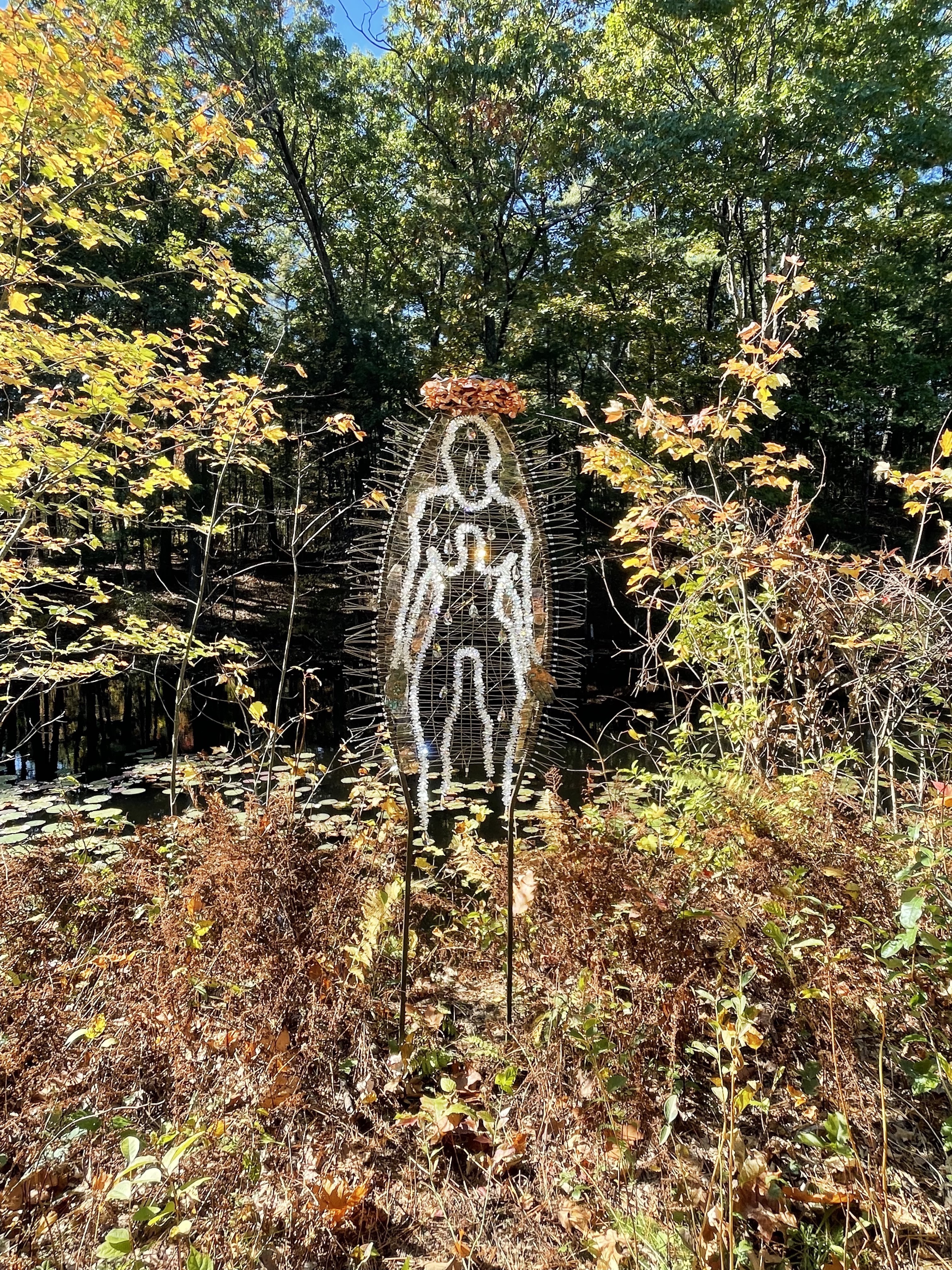 Orchard Guardian (2021)
Orchard Guardian (2021)
Steel, stainless steel cable, lead crystal, mica, copper
Artist Statement
The telltale signs of human presence can be seen and felt, even in wilderness. Humans no longer need to be in proximity to impact even the most remote places. This figureis symbolic of human presence over time.
Bio
Carolyn Enz Hack grew up on a farm in northwest New Jersey. She holds a BFA in theatrical design from the Mason Gross School of the Arts at Rutgers University and is currently enrolled in the New York Studio School of Drawing and Painting atelier program. She is the recipient of two Vermont Arts Endowment Awards for new work and her work has been written about in Sculpture, So Vermont Arts & Living, Art New England, Northern Woodlands, New Hampshire Home, and New England Home. Her studio is in Thetford Center, Vermont.
Robert Greene
Veins Arteries Earth (2019-20)
Uprooted plum tree, grape vines, electrical wire
Artist Statement
We as human beings, as organic creations of the Earth have forgotten this connection to the natural environment. We are here and gone in the blink of an eye. Just like this dead root ball in which this figure is suspended and entwined, we too will have our moment to shine before we return to our mother. Our red arteries and blue veins pulse simultaneously with the life that surrounds us. We are delicate creatures. Our very fabric of life depends on the natural order and the natural world. We are Earth; the Earth is us.
Mixer (reworked in 2022 from earlier work)
Teak wood
Artist Statement
Just as real cement mixers are extremely messy, often spilling cement everywhere, this mixer is portraying the same carelessness that occurs when using one of these machines. However, just as in real life, eventually over time nature finds its way through the cracks or even grows over the cement thereby adopting it into a natural habitat. The contents of this mixer will allow nature to do the same, as natural locally found flora will be planted within the large teak strips. They will be secured to the ground and turn silver gray over time in direct contrast with the greenery that will continue to grow through them.
Have a Seat (2016)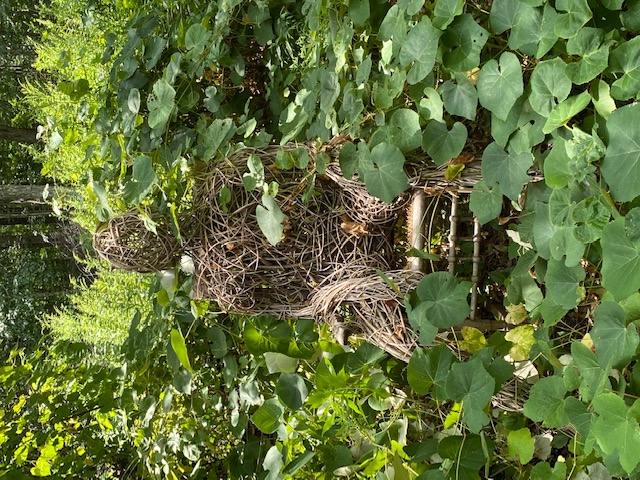
Rocking chair, wicker, reed
Artist Statement
This piece reflects the precarious situation we find ourselves in when standing by as a witness simply isn’t enough. Choosing not to act, and its result. We are all part of this river of life and all have a part to play. Nature does not get involved in our politics and micro worlds. Choosing to remain silent or still as our natural world suffers, has its consequences. There is a point of no return.
Bio
Robert Greene is an East Coast artist/sculptor who resides in Oakdale CT. His work deals primarily with the human condition. The activity of the mind and nervous system is his main inspiration. Graduating from Eastern Connecticut State University in 2006, he went on to pursue a Master's in Fine Art at the University of Massachusetts Dartmouth in 2010, receiving his Master's in 2013. He is currently a full time Associate Professor of sculpture in the Department of Art and Art History at Eastern Connecticut State University. His sculptures have gained recognition along the East Coast with many pieces in both private and public collections. His work has been mentioned from local newspapers to The Boston Globe. Recently Robert had a sculpture featured in the New York Times where it was highlighted in a prominent room at the Annual Kips Bay Decorator Show House. Robert's work has also been seen in Architectural Digest, Huffington Post and many papers and blogs. He continues to exhibit in conjunction with staying busy creating original pieces and making new discoveries in his studio in Ledyard. He enjoys nurturing the creative minds of his students by engaging them in thought provoking projects. He believes that creativity and innovation go hand in hand.
Belen Millan
DISRUPCION I & II (2022)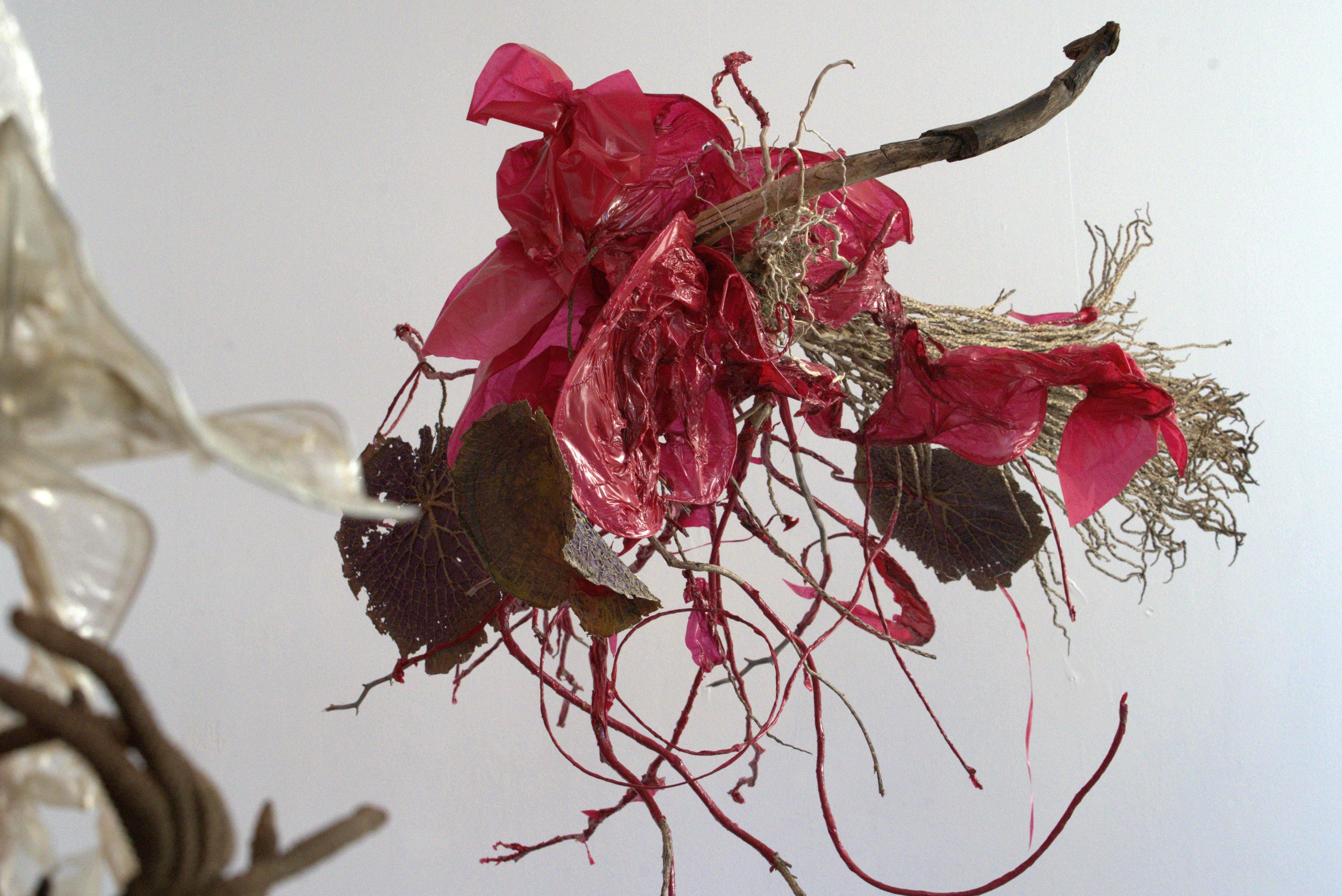
Site specific installations created fusing rotted, standing trunks with recycled and recyclable plastics, polyester yarns and metal.
Artist Statement
DISRUPCION refers to the actual rupture of the balance between life and death brought about by the intrusion of plastics. Nature is no longer the same after the introduction of plastics to our modern life. The water in our rivers, lakes, oceans, the soil in our parks, our plants and trees have been penetrated by plastics and microplastics that do not degrade. DISRUPCION attempts to make visible the invisible – to bring light to the terrifying penetration of synthetic polymers in our environment and our own bodies. DISRUPCION I and II address the intrusion of plastics and microplastics in Nature. Dead trunks at different stages of decay have been fused with plastics creating a new Hybrid Nature where the natural and unnatural are merged. All plastics used in these installations are recycled and recyclable and will be 100% removed once the show is over. #disrupcion #sitespecificinstallation #microplastics #hibridaproject #recycledart #recycledplastic #plasticnature #plasticintrusion #belenmillanabstractions
DISRUPCION III (2022)
Site specific installation consisting of a number of organic hybrid sculptures using a falling dead trunk, dead organic matter, steel, recycled and recyclable plastics, wires, plastic hoses and pipes
Artist Statement
This site-specific installation focuses on the intrusion of microplastics in our own blood stream. Recent studies estimate that each person ingests, on average, about five grams of plastic per week that are found in our water, air and food. That amount is equivalent to a credit card. Studies have recently found microplastics in our blood stream. The discovery shows that particles can travel around our bodies and may lodge in any organ. Impact to our health is yet unknown. All plastics used in this installation are recycled and recyclable and will be 100% removed once the show is over. #disrupcion #sitespecificinstallation #microplastics #hibridaproject #recycledart #recycledplastic #plasticnature #plasticintrusion #belenmillanabstractions #inthebalance
Bio
A Spanish-American artist, Belen (belenmillan.com) lives and works between Malaga, Spain and New York. Belen's visual language brings together her multicultural background and environmental concerns. Her biomorphic abstractions in diverse media reflect on the symbiotic relationship between Humans and Nature as well as the precarious balance between life and death, chaos and order, damage and renewal that is constantly challenged by human intervention. Belen has been showing extensively in the US and Europe for the past twelve years and her work is held in public and private collections. She graduated with a Bachelor of Arts, Cum Laude, from Mount Holyoke College and a Masters Degree in Communications by Columbia University, SIPA. She also studied Art History at Hunter College and Studio Art at the Woodstock School of Art and the Arts and Student League of New York.
Wanda Strukus
This is a Test of the Emergency Broadcast System (2022)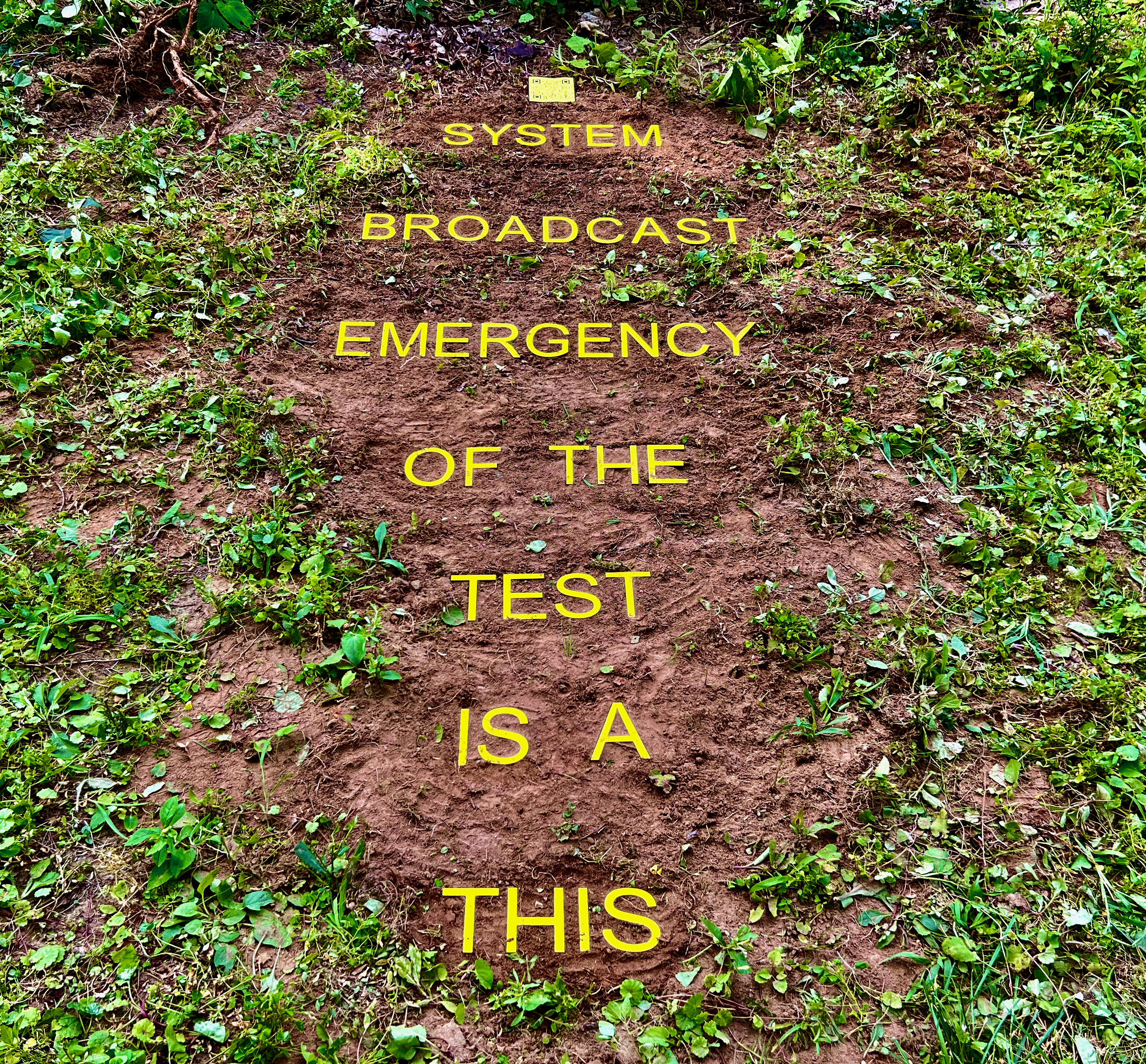
Audio, Wood
Artist Statement
This Is A Test Of The Emergency Broadcast System is a soundscape that incorporates field recordings from the Fairyland Pond site, music, found sounds, and human voice to create an imagined dialogue between the earth and human beings in crisis. Natural sounds are layered, modified, and combined with music and snatches of spoken text to build a sense of layered worlds - nature speaking in the foreground, the human world encroaching in the background, with periods of friction, exchange, synchronicity, disruption, and agreement. Using emergency broadcasts and alert messages from the federal government/FEMA as a point of departure, the soundscape explores the earth, our fellow life forms, and our human selves as a collaborative first-alert system, raising the alarm while also providing moments of surprise and ease, contrasting the magic of the natural world with the peril of losing access to nature, and finding an uneasy balance in between. Can be accessed on site via scanning a QR code, but due to incocnistent mobile service, it's recommended to access sound in advance of arrival by scanning or clicking on the code. Headphones recommended.
Bio
Wanda Strukus is a movement-based sound artist whose practice emphasizes interdisciplinary exploration in the fields of sound, deep listening, dance/movement, and storytelling. Recent sound projects include Canal Song (soundscape for Sound on Mystic, 2021) Daphne: Frogs and Fireworks (2021), Sounds for Other Dances (2021), and sound design for For a Nickel I’d Do It Again (Penny Benson/PEM-PM). As a dance/movement artist and choreographer, she has worked with Daniel McCusker Dance Projects, Brian Crabtree and Dancers, Penny Benson, Yellow Springs Theater Company, and Greater Boston Stage Company, and has taught and directed/choreographed at universities throughout New England. She holds degrees from Tufts University (drama/puppetry/masked performance), University of Arizona (theater/playwriting), and Wesleyan University (film). She is an alumna of the Jacob’s Pillow Choreographer/Director Lab and teaches movement and Viewpoints/composition at Boston Conservatory at Berklee.
Jose Trejo-Maya
Transparencies in Time; Cuahpohualli embedded in enthnopoetic language poetry (2020-2022)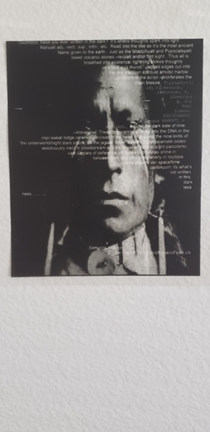
Artist Statement
These poems come from dreams and surrealist experiences while in ceremony with Chololo medicine men in the Tule River Reservation. My poems came from dreams I've have had and I brought them back to reality by writing them down.They were created in moments of serenity and an acute awareness that arose out of two decades of study and keen awareness. It's surrealist abstract art. It's things that I've lived in and felt them as a breathed them and felt them in the bone marrow. Nahuatl is the native language spoken in various regions in Mexico and Nahuatlacah is the speaking people. The language root of the poetics is Nahuatl in its concept of tlalamictli i.e. memory while, Cuahpohualli is a pre-Columbian conception of time, commonly known as the sunstone calendar. These poems were created as a spark of memory and reminiscence of a time and place that no longer exists. My objective is literacy and dialogue. One pays homage to our ancestors by remembering them thus my poetry is a refraction of where I'm from.
Bio
I am a remnant of the Nahuatlacah oral tradition, a tonalpouhque mexica, a commoner from the lowlands (i.e. Mexico) from a time and place that no longer exists. At present my poetry has been reified as it has been published in the UK, US, India, Spain, Australia, Argentina, Germany and Venezuela. I have been exhibited in different venues with a work that’s titled: Transparencies in Time: Cuahpohualli embedded in ethnopoetic language poetry. I seek to expand on this work into a comprehensive exhibit in a gallery in 3D (i.e. three simultaneous exhibitions that expand into multiple levels of perception and/or dimensions).I was born in Celaya, Guanajuato, Mexico, where I spent my childhood in the small neighboring rural pueblo of Tarimoró and whence my family immigrated in 1988. My inspiration(s) include Netzahualcoyotl, Humberto Ak’abal, Ray A. Young Bear, and James Welch.
Rebecca McGee Tuck
Trapped at Sea (2020)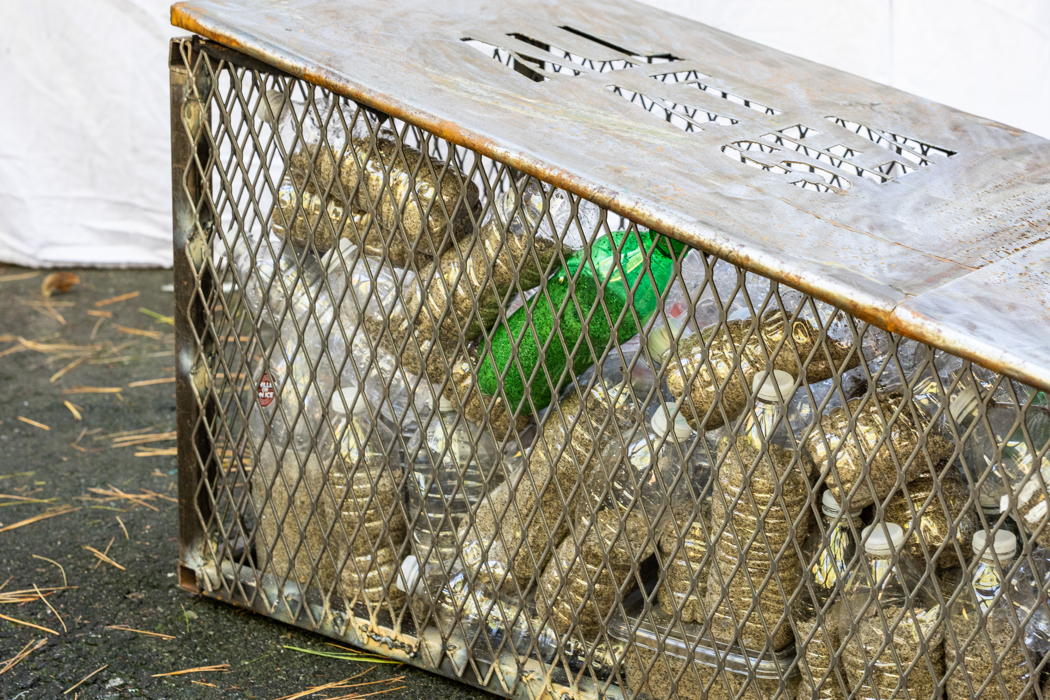
Steel, single use plastic bottles, beach sand
Artist Statement
Millions of tons of plastics are found in the ocean. Unknown quantities of plastic bottles are "Dead in the Water" and break down into tiny toxic micro plastic particles, attracting birds and sea creatures who consume them. It takes over 400 years for a plastic water bottle to degrade, while leaching toxic chemicals into the water as they break down. Let’s not be "All At Sea" about our addiction to plastic! Plastic pollution, in our hands, on the side of the road, or on our beaches will find its way into our oceans. Why does this matter? The ocean is the largest ecosystem on Earth and it is the planet’s life support system. Making one single reusable swap can spare the environment hundreds of plastic bottles each year. Together we can all work towards a cleaner Ocean and "Stem the Tide" of the problems of plastic waste!
Bio
Rebecca McGee Tuck is a fiber artist, a sculptor and a collector of lost objects. Her work is a visual narrative of what she accumulates from a throw away society and as a result she gives new life to what others discard. Tuck has shown her work in multiple juried shows throughout New England including Boston Sculptors Gallery, the Fitchburg Art Museum and the P.E.G. Center for Art and Activism and has been featured in Artscope and Juniper Rag Magazines. She recently won the Present Tense Award from ArtsWorcester which recognizes an artist whose work exemplifies new practices, artistic risk-taking, and excellence in execution. Tuck works among her menagerie of debris from her studio at the Mill Contemporary Art Studios in Framingham.
See the previous Art Ramble


